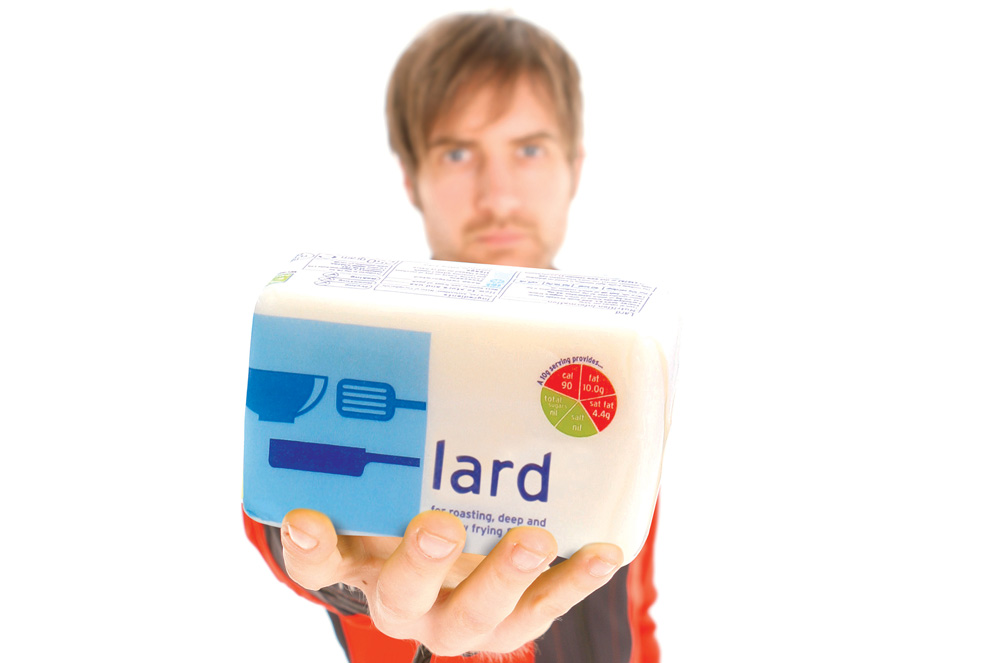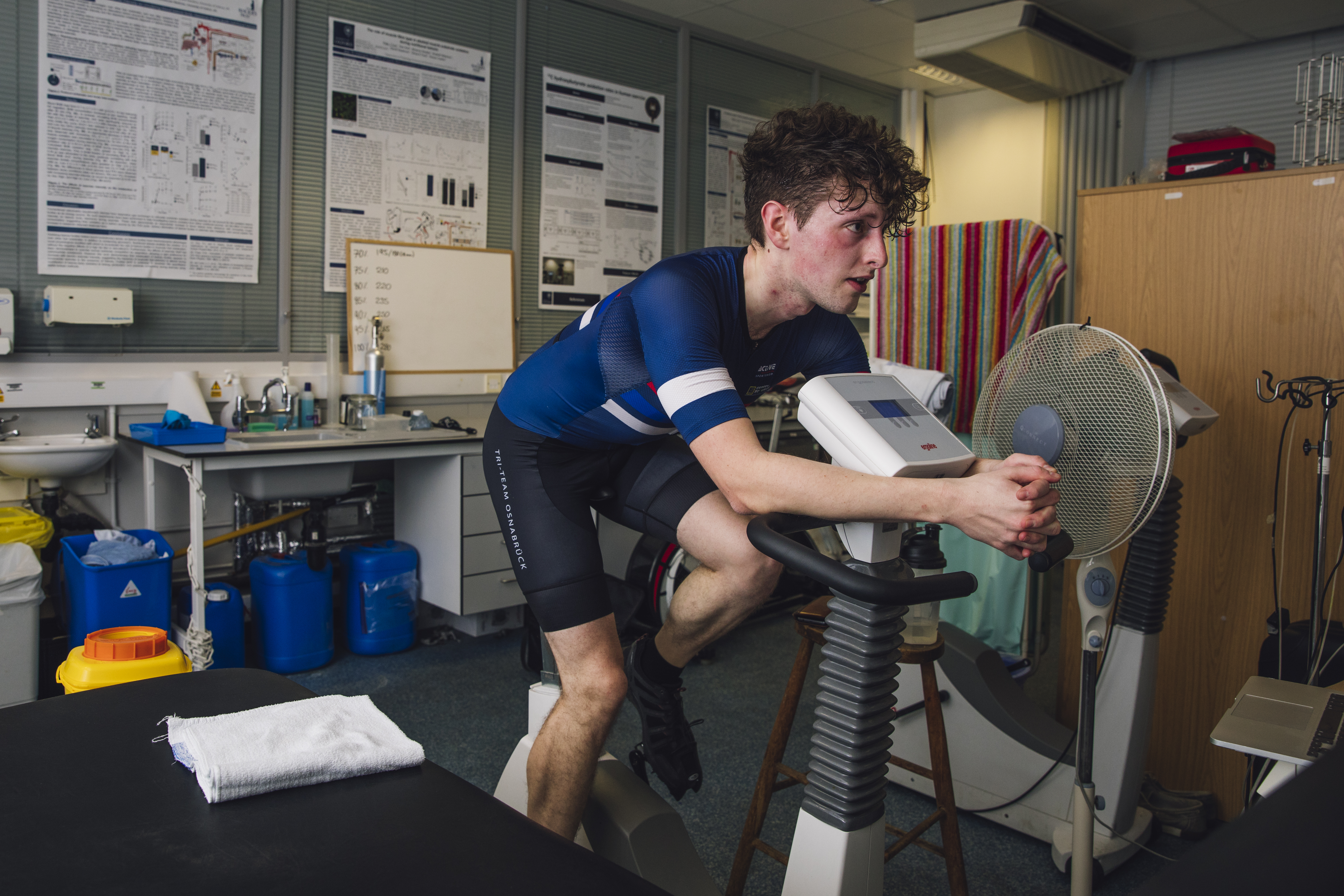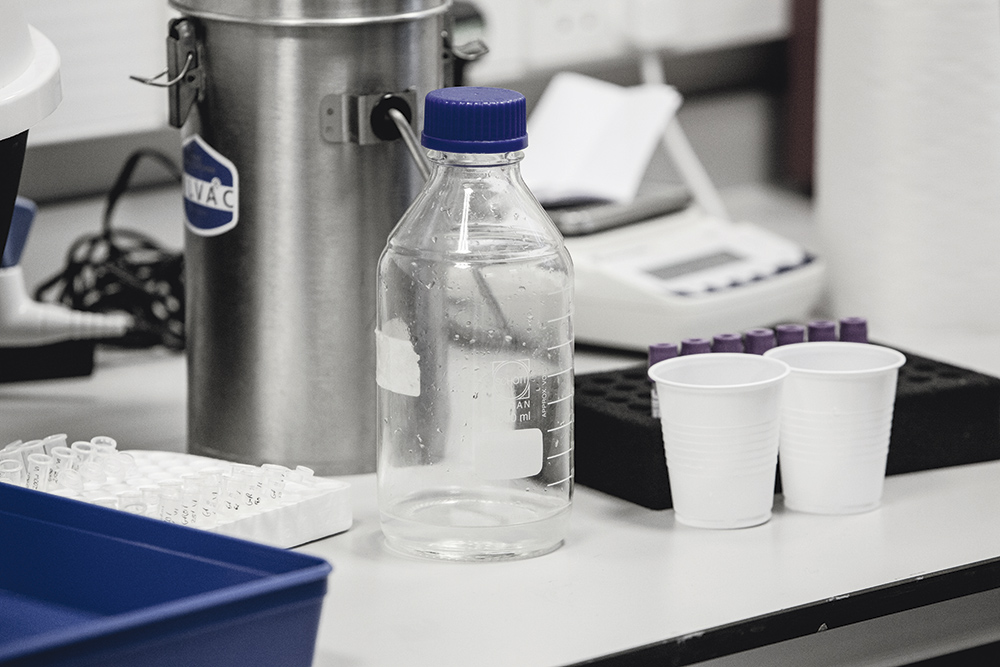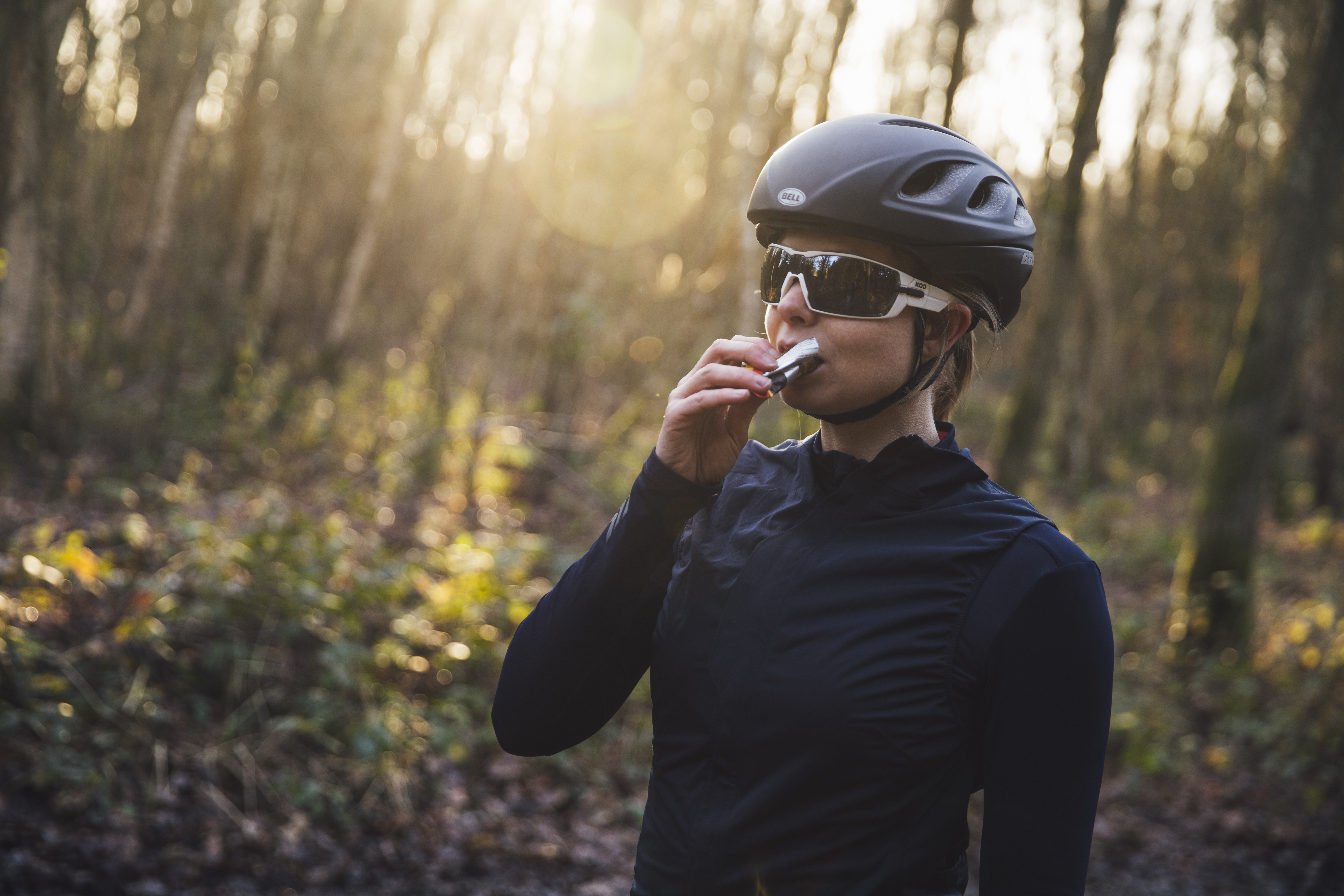Does Biking Burn Fat All Over
You're full of fat. No offence. We all are. Even a lean athlete has around 100,000 calories of the stuff stored away, predominantly nestled under the skin and within muscles.
When we ride, it's carbohydrates — of which the body can store just 2,000 calories' worth — we guzzle, in the form of drinks, bars and gels.
It's hardly surprising, then, that cyclists have long been looking for ways to make the body shovel more fat into the fuelling furnace. But despite all the hype around fat-burning, can we really access this near-limitless fuel source to ride further and faster?
>>> Nutrition for cycling explained
Let's have a go at separating the facts from the wishful thinking…
Macronutrients explained
Your body's nutritional requirements can be broadly split into three macronutrients: carbohydrate, fat and protein.
Carbohydrate is broken down into glucose for immediate use and any excess is converted into glycogen to be stored in the muscles and liver for later use. Converting carbs into energy requires less oxygen, compared to metabolising fat, so when you're exercising at around 70 per cent of your max heart rate (or above), your body is fuelling almost entirely on carbs.
On longer rides, topping up with carbs is essential. Failing to do so means 'bonking' or 'hitting the wall' — remember, we store only around 2,000kcal of carbs, enough for two to three hours of riding.
You have enough fat, meanwhile, to fuel several days of low-intensity riding (no, we don't advise putting that to the test). Fat-fuelled riding is slow riding; above a moderate pace, you rely on carbs.
The last of the big three is protein, which crucially supplies muscle protein synthesis — the building and repair of muscle.
Protein can be used as a fuel, but the body only resorts to this when other sources are low.
Ketogenic diets: can we cut carbs to burn more fat?

Proponents of high-fat, low-carb diets claim that eating a smaller proportion of carbs promotes the utilisation of muscle fat, thereby loosening carbohydrate's grasp as our dominant fuel source.
If carbs are chronically restricted, the body enters a state of ketosis — fuelling on ketones and stored fat.
Ketogenic diets are used, in a controlled environment, to treat epilepsy and can sometimes be used to combat Type-2 diabetes.
More recently, high fat, low-carb has gained popularity as a lifestyle and weight loss diet — followers avoid not just complex carbs but also fruit and root veg. Expect the larder of a keto-convert to be stocked with olive oil, avocado, butter, beef, cream, eggs, fatty fish, leafy greens and nuts.
In theory, it's ultra-endurance athletes who stand to benefit the most: fat can feed the body at lower intensities, and a lesser reliance on refuelling during an event can cut down on gastrointestinal disturbance.
A ketogenic diet does have its place, according to Kieran Clarke, professor of physiological biochemistry at Oxford University, whom we visited at her lab.
"Some people become really efficient fat-burners by changing to a ketogenic diet — but only for ultra marathons and long-distance events like that. They'll never sprint, but they can go steadily for a long time."
It's a trade-off that won't suit the vast majority of amateur riders. Who wants to lose the town sign sprint before it's even begun? Ex-pro and director at Dig Deep Coaching, Stephen Gallagher, puts it succinctly: "There's not much point finishing a race and thinking, 'Great, I used no sugar in that ride' if you're 30 minutes down."
I tried going Keto

Endurance cyclist Mike Stead, 45, decided to test out a ketogenic diet (75 per cent fat, 10 per cent carbs and 15 per cent protein) while training for and taking part in the 300km Mighty Corinthian ride in the Lake District.
"I'd done a lot of day-long endurance racing before entering the Mighty Corinthian. I'd find I just couldn't eat any more after around 4pm; I'd feel ill and start to slow down. I wanted to go faster, but just didn't have the energy anymore, as I'd not been able to fuel enough.
"I was looking for a better fuelling strategy. So, I went on a ketogenic diet. At first, it was awful, much like a two week hangover. I stuck with it, and about a week and a half in, I felt a bit better and went for a ride. I rode 100km on a cup of coffee, and only in the last 10km hit the wall. About two weeks later, I went and did a harder ride. When I came back, I wasn't hungry.
"I did the 2016 Mightly Corinthian ride on the ketogenic diet. I finished second, in 15hr 40min, and I was fresh as a daisy. I felt like most people would have after riding 50km, and all I'd eaten was a piece of quiche, a yoghurt, a bowl of olives, and a pie. "For me, the limiting factor is that you lose your ability to go hard. I'd blow up if I went over 75 per cent of max heart rate. I was constantly watching my heart rate — I knew I'd crash if I went over that threshold.
"I did the diet again when training for the Dirty Reiver race. If I had a big endurance ride, I'd do it because I know I can go through a week of feeling a bit rubbish and then I can turn up and knock out 300km and feel great. But for me, it's not a long-term solution."
Can we trick our bodies into burning more fat?

Paul Zimmer-Harwood puts ketones on trial at Oxford Uni
There may be another way to obtain the benefits of fat without forfeiting access to all zones over threshold.
Ketone drinks, originally developed for use by the US army, provide pure ketone. Consumed alongside carbohydrates, they are believed to increase the use of fat to fuel working muscle at intensities below around 70 per cent of max, in theory sparing carbohydrate for when it's needed: at higher intensities, on climbs and sprints.
Professor Clarke, who developed the ketone ester used and sold by the brand HVMN, told us: "HVMN had six Tour de France teams using it this year [2019], and from all reports, it worked very well."
The drink was also used by Vittoria Bussi when she broke the Hour Record in September 2018.
Dr Brianna Stubbs, head of science at HVMN, believes the drink aided Bussi's 60-minute effort by helping to conserve glycogen: "We have seen that ketones can contribute 15 to 20 per cent of energy during exercise, reaching a max contribution at around 75 per cent of VO2max."
According to Stubbs, ketones, unlike fat, can be utilised at high intensities — thereby sparing carbs.
"Fuel availability is not likely to be a key limiting factor in a one-hour effort," she admits, "but having 500 calories of glycogen remaining instead of just 250 would set you up better for a ramp up in effort towards the finish line... Vittoria's lap times surged at around 45 minutes to go."
Research into the effects of ketone drinks on athletic performance is in its infancy; some studies have supported their effect on performance immediately following consumption, whereas others (including our own — see below) have shown no benefit.
David Dearlove, a researcher at the University of Oxford, is currently investigating how supplementing athletes with a ketone drink for 10 days affects adaptations made in response to exercise training.
"If you keep doing the same exercise time and time again, you get a plateau effect — your muscle will respond to the same stimulus only so far. A ketogenic diet can be used as an additional stressor to stimulate further adaptation," he pauses — there's a downside coming.
"However, having tried it, it's not fun. Your ability to concentrate is diminished and your capacity to do any high intensity exercise is suppressed."
What is the scientific hypothesis?
"We know that ketones are important signalling molecules, forcing your muscle to use more fat and limiting the use of carbohydrate. In this study, we wish to understand whether giving an athlete ketone drinks during a hard training block can mimic some of the adaptations achieved by adopting a ketogenic diet, potentially increasing the muscle's capacity to use fat, but without the need to abstain from carbohydrates."
The answer is yet to be revealed, but Dearlove is confident.
"For most athletes, adopting a ketogenic diet is not a practical or desirable option, yet there is no doubt it forces your muscle to increase its capacity to use fat. Ketogenic diets and the ketosis resulting from the ingestion of ketone drinks are distinct physiological states, but if some of the same effects can be achieved, [drinks] may offer athletes another method to boost favourable adaptations."
Putting ketones to the test

Studies into the effectiveness of ketone drinks to elevate immediate performance show mixed results. Cycling Weekly decided to (informally) test the HVMN Ketone Ester concoction on two amateurs, with one control drinking a placebo. We had the riders complete the hour-long 4DP test, Full Frontal, devised by Apex Coaching for The Sufferfest.
| 5 second | 5 minute | 20 minute | 1 minute | |
| R1, placebo | 1114 | 311 | 222 | 410 |
| R2, ketone | 1088 | 295 | 225 | 402 |
| R2, placebo | 801 | 241 | 210 | 286 |
| R2, ketone | 763 | 239 | 208 | 283 |
| R3, placebo | 943 | 293 | 230 | 378 |
| R3, placebo | 1010 | 296 | 228 | 408 |
Our results show no performance boost for ketones but the small sample size limits the conclusions that can be drawn.
Do fasted rides help us burn more fat?

Access to ketone drinks is limited: three 25g bottles from HVMN will set you back $99 (£76). A cheaper option is the fasted ride, which many riders trust as a method of increasing their fat burn, often with the objective of weight loss.
The practice is simple: rip the rider from their slumber, and send them on a long ride, collecting little more than a black coffee as they bypass the breakfast table.
Those using such rides solely for weight loss are in for a nasty surprise — as nutritionist Will Girling explains: "At one point, researchers suggested that you oxidise more fat when you do exercise in a carbohydrate fasted state. In its acute setting, it can be said that that is additional fat-burning, but it only applies during the ride."
Now for some basic maths. "If you took two identical individuals, one did a ride fasted, the other a fuelled ride, both burning 500 calories, the former will oxidise more fat during the ride. However, over a 24-hour period, the net calorie burn is the same."
Fasted rides do have a place, but not for weight loss. "Restriction of carbohydrate results in greater mitochondrial biogenesis, increasing cells' aerobic capacity. It causes a heightened response to the exercise, so you'd get fitter quicker — but it won't have an effect on body composition," adds Girling.
Fasted rides are not a shortcut or easy option. Gallagher believes amateurs can reap greater benefit from riding harder in a fully fuelled state. "If you go out and do a four-hour training ride in the Peak District, you can do it carbed-up and absolutely smash it, burning 3,500 calories. But if you try and do that fasted, you won't be able to induce the same training stimulus."
Restricting carbs is a risky practice that needs close monitoring.
"I might advise some riders to do up to an hour fasted in the morning, but it's more a 'wake up' than for fat loss. For elite athletes, I might have them do the last two of a four- or six-hour ride taking on only protein — it's safer that way, as they've been carbed-up for most of it, and it's never about weight loss."
Why do you want to burn more fat anyway?
"Fat burning" is a term that sounds like it should be related to losing weight. But while ketogenic diets and fasted rides can result in lost pounds simply from consuming fewer calories, the weight of evidence suggests that they're really more effective when used as methods to adjust the body's fuel adaptability for endurance events.
"If your target is an hour time trial, to go as fast as you can, I wouldn't worry about fat adaptation. Give your body the carbohydrate it needs, and train harder," says Dearlove.
"But if your goal is to do long endurance racing, like Haute Route multi-day events, then it could be beneficial to train your body to try and use fat — a fuel that is more abundant. It's very difficult to consume enough food to replace spent glycogen stores when performing successive days of hard training or racing".
Burning body fat to lose weight

When it comes to losing weight, it's all about intake versus expenditure.
"You ultimately need to be in a calorie deficit to change your body composition," says Girling. A calorie deficit can easily mean a shortfall in training energy, though, which can backfire if you're not careful.
>>> How to lose weight cycling
Hence, Girling and Dearlove advocate 'periodised nutrition', which simply means adjusting your intake for the session ahead.
"You can easily work out your calorie burn per week, and use that to give yourself a daily calorie requirement," says Girling. "You'll lose weight if you accrue a deficit. But that average intake might not be enough for the days when you have an intense session."
"A lot of amateur riders will be doing high-intensity one-hour turbo sessions during the week. A low-carbohydrate diet won't work for those — you won't be able to perform at a high enough intensity." Far better to limit calories on the days when you take a break from training.
"On rest says, your calorie requirement is minimal. The main driver of recovery is protein, so you can cut back on carbs and fat and get your protein in," says Girling.
Every gram of glycogen your body stores is accompanied by three to four grams of water, so low-carb diets can seem to bring overnight success. Be warned, restricting carbs too severely and slipping into a state of relative energy deficiency (RED-S) is linked to suppression of the immune system, hampered performance and even weakened bones.
Girling urges athletes to aim for weight loss of no more than one per cent of body weight per week, 0.5 per cent for leaner individuals. The reliable rule of thumb is: "fuel for the work required".
If the work required is a crit race, fast dual carriageway time trial or sportive, your body needs carbohydrates to train and perform. If the goal is a week-long endurance event or 300km in a day, teaching your body to put fat to good use might help you along. For weight loss, though, it is as simple as making sure 'calories out' exceed 'calories in' — using care and caution, and fuelling every ride appropriately.

Cycling Weekly's Tech Editor Michelle Arthurs-Brennan is a traditional journalist by trade, having begun her career working for a local newspaper before spending a few years at Evans Cycles, then combining the two with a career in cycling journalism.
When not typing or testing, Michelle is a road racer who also enjoys track riding and the occasional time trial, though dabbles in off-road riding too (either on a mountain bike, or a 'gravel bike'). She is passionate about supporting grassroots women's racing and founded the women's road race team 1904rt.
Favourite bikes include a custom carbon Werking road bike as well as the Specialized Tarmac SL6.
Height: 166cm
Weight: 56kg
Source: https://www.cyclingweekly.com/fitness/how-to-burn-fat-cycling-163887
